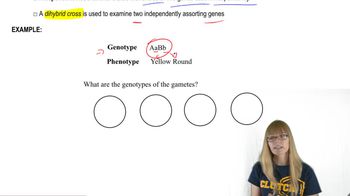Table of contents
- 1. Introduction to Genetics51m
- 2. Mendel's Laws of Inheritance3h 37m
- 3. Extensions to Mendelian Inheritance2h 41m
- 4. Genetic Mapping and Linkage2h 28m
- 5. Genetics of Bacteria and Viruses1h 21m
- 6. Chromosomal Variation1h 48m
- 7. DNA and Chromosome Structure56m
- 8. DNA Replication1h 10m
- 9. Mitosis and Meiosis1h 34m
- 10. Transcription1h 0m
- 11. Translation58m
- 12. Gene Regulation in Prokaryotes1h 19m
- 13. Gene Regulation in Eukaryotes44m
- 14. Genetic Control of Development44m
- 15. Genomes and Genomics1h 50m
- 16. Transposable Elements47m
- 17. Mutation, Repair, and Recombination1h 6m
- 18. Molecular Genetic Tools19m
- 19. Cancer Genetics29m
- 20. Quantitative Genetics1h 26m
- 21. Population Genetics50m
- 22. Evolutionary Genetics29m
3. Extensions to Mendelian Inheritance
Understanding Independent Assortment
Problem 24b
Textbook Question
Textbook QuestionOrganisms with the genotypes AABbCcDd and AaBbCcDd are crossed. What are the expected proportions of the following progeny?
a phenotype identical to either parent
 Verified Solution
Verified SolutionThis video solution was recommended by our tutors as helpful for the problem above
Video duration:
2mPlay a video:
Was this helpful?
Key Concepts
Here are the essential concepts you must grasp in order to answer the question correctly.
Genotype and Phenotype
The genotype refers to the genetic makeup of an organism, represented by alleles (e.g., AABbCcDd). The phenotype is the observable physical or biochemical characteristics resulting from the genotype, influenced by both genetic and environmental factors. Understanding the relationship between genotype and phenotype is crucial for predicting the traits of offspring in genetic crosses.
Recommended video:
Guided course

Gamete Genotypes
Mendelian Inheritance
Mendelian inheritance describes the patterns of inheritance for traits controlled by single genes, as established by Gregor Mendel. Key principles include the segregation of alleles during gamete formation and independent assortment of genes located on different chromosomes. These principles help predict the expected ratios of phenotypes in progeny from genetic crosses.
Recommended video:
Guided course

Organelle Inheritance
Punnett Square
A Punnett square is a diagram used to predict the genotypes and phenotypes of offspring from a genetic cross. By organizing the possible gametes from each parent, it allows for the visualization of potential combinations and their probabilities. This tool is essential for calculating the expected proportions of progeny with specific traits, such as those identical to either parent.
Recommended video:
Guided course

Chi Square Analysis

 4:58m
4:58mWatch next
Master Gamete Genetics and Independent Assortment with a bite sized video explanation from Kylia Goodner
Start learningRelated Videos
Related Practice


